- Established 1982 -HOME: www.hiltonpond.org
THIS WEEK at HILTON POND Subscribe for free to our award-winning nature newsletter (Back to Preceding Week; on to Next Week) |
JUNE? SLOW NATURE MONTH? Late April and early May 2020 were quite busy at Hilton Pond Center, what with migratory birds arriving from the Neotropics and many winter species still mingling with our year-round residents. Thus, June was a bit of a reprieve after all the pass-through migrants and other northern breeders departed and local birds were tending to nesting duties; females were on eggs or chicks and much less visible, while males lurked in nearby shrubbery--keeping an eye out for interlopers. Some individuals were going through molt, an energy-sapping process that may require periods of rest and staying out of sight.
All text, maps, charts & photos © Hilton Pond Center Even so, seed levels in our feeders continued to drop rapidly in June; everything from House Finches to Northern Cardinals (both above) and Downy Woodpeckers to Carolina Chickadees couldn't seem to get enough sunflower snacks while browsing a cornucopia of wild bugs and berries that comprise their natural summer diet. Yes, we feed songbirds all year long at the Center, a somewhat expensive strategy that--along with providing daily entertainment--keeps those aforementioned avian species handy for our on-going banding research. (And don't even ask us how much sugar we buy during hummingbird season!) Although birds were somewhat less diverse around Hilton Pond in the month just completed, there was plenty going on in the natural world--as noted in our account below of the Center's "June Miscellany."
All text, maps, charts & photos © Hilton Pond Center At Hilton Pond Center parts of June were so warm and sticky--highs close to 90° and heat indices at 100° or more--we were hesitant to deploy mist nets. When it gets that hot it stresses netted birds, plus it's no fun for the bander/bird extractor standing out there in the heat. Most days we just baited a couple of hanging traps with a tube feeder containing sunflower seeds, keeping a close eye and quickly removing captured birds such as American Goldfinches (above). Such was the case on 11 June when at about 10 a.m. we saw three smallish brown birds caught in a tube feeder trap outside the kitchen window of the Center's old farmhouse. Even from a distance we recognized them as House Finches (HOFI)--one of our most commonly banded species here during summer months, and winter, too.
All text, maps, charts & photos © Hilton Pond Center Just how common are HOFI around Hilton Pond, you might ask? Well, that morning when we handled the third bird of the trio (see photo above) it became the 11,000th House Finch banded at the Center since 1982! Hey! That's a LOT of finches! For several years after we came to what is now Hilton Pond Center, nearly all HOFI we banded locally we caught in fall or winter after they had migrated from up north. It wasn't until the late 1980s--when many members of the species just stopped migrating and began nesting regularly in the Carolina Piedmont--that we started to get big HOFI numbers in spring and summer. Now, for the past 30 years, we have no evidence that ANY winter House Finches we band are migrants from afar; all appear to be produced in nearby nests and spend their lives locally. All three of those HOFI on the 11th were recent fledglings, which we expected. June through August we seldom catch unbanded adults at the Center--although we DO occasionally recapture banded males and females in breeding condition. This June, for example, we encountered an after-sixth-year male House Finch banded back in January 2015, making him among the oldest-ever of his species at Hilton Pond. This month we also recaptured a fifth-year HOFI and two fourth-year (one of each gender). House Finches have indeed become common in the Southeastern U.S. We wonder how many Carolinas bird feeding stations like ours have hosted at least 11,000 of them in the past 39 years?
All text, maps, charts & photos © Hilton Pond Center (CAUTIONARY COMMENT: At this time of year, adult male HOFI are identifiable by their raspberry red plumage, but brown House Finches at your feeder in June could be adult OR immature females OR immature males. A very few young males start to show red spotting by the end of June--see photo above--but most won't get "adult" full red feathering until late summer or early fall. By Halloween you're safe in saying male or female.)
All text, maps, charts & photos © Hilton Pond Center On the evening of 24 June the pine woods were ablaze across a field adjoining Hilton Pond Center—perhaps preview of spectacular sunsets predicted to occur when a massive high-altitude sand cloud from the Sahara arrived a few days later. Those vaunted sunsets never came to pass locally, just heavy all-day haze with an odd earthy fragrance. Just as well; we like the quiet pastels in the panorama above.
All text, maps, charts & photos © Hilton Pond Center Last fall we started watching a shiny, yellow-striped lizard that liked to sun on the bark of a Flowering Dogwood just outside our office window. The tree actually grows through the back deck, so it was easy for the lizard to scurry down the tree trunk and across the wooden planking in pursuit of some delectable insect. In October the lizard had an electric blue tail that gave it and some relatives the collective nickname "Blue-tailed Skinks." Confusingly, three different Carolina lizards have blue tails as youngsters, so we weren't able to identify our lizard to species. However, in addition to being blue, the tail of this particular individual was quite distinctive: After being damaged near the tip, the tail regenerated but instead of growing straight out it branched sideways and gave the lizard a forked appendage (see photo above). This spring we were pleased to see ol' fork-tail again, but over the winter it had continued to mature. The blue in its tail was gone, replaced by a silvery color--and its bright yellow longitudinal stripes had begun to fade. Even more noticeable: Its head was turning a bright orange color, telling us this was a male. Nonetheless, we still didn’t know his species; we needed a detailed mug shot to solve that mystery; we were pleased the lizard sat still in the sun long enough for us to get the one just below.
All text, maps, charts & photos © Hilton Pond Center The Carolinas' three "Blue-tailed Skinks" are Broad-headed Skink (Plestiodon laticeps), Common Five-lined Skink (P. fasciatus), and Southeastern Five-lined Skink (P. inexpectatus)--the latter two extremely similar in appearance. (Taxonomy note: Some authorities use Eumeces instead of Plestiodon.) Broad-headed Skinks are one of the biggest lizards in the Carolinas, reaching up to 13" in length; adult males have a noticeably large orange head and dark, unmarked bodies. With the mug shot on our computer screen, we also pulled up a comparative photo (left, courtesy the Virginia Herpetological Society) showing heads of P. laticeps and P. faciatus. Note there are only four scales on the upper lip of P. fasciatus from nostril to eye, while P. laticeps has five. It so happens P. inexpectatus also has five lip scales, while the lizard in our own photo clearly bears just four. That meant our fork-tailed dogwood lizard had to be P. fasciatus--the Common Five-lined Skink. Cool! Mystery solved! We'll be watching him this summer to see if his stripes continue to fade. Here's hoping he doesn't lose his distinctive tail in a territorial encounter with another lizard--or with a pesky predator. (NOTE:
All text, maps, charts & photos © Hilton Pond Center Reptiles other than lizards were likewise basking in the sun on hot June days, including our plentiful Painted Turtles, Chrysemys picta--the one above lolling on on a mostly submerged tree limb in Hilton Pond. Draped with tiny granular Rootless Duckweed, its six-inch-long shell shined as the turtle craned its neck to keep an eye on the photographer. This was undoubtedly a mature individual whose yellow facial markings are mostly faded; it could be 30-50 years old and likely spent all its years in our little one-acre impoundment. Seeking a better image we moved a half-step step closer and the turtle slipped off into still water, leaving behind a male Eastern Amberwing, Perithemis tenera, on the tip of the perch. This is one of the smaller dragonflies, with body only about an inch long. Females have brown abdomens with colorless wings often ornamented with black spots; in close view both sexes show a red spot on the lead tip of the forewings.
All text, maps, charts & photos © Hilton Pond Center The 26th of June was a notable day at at Hilton Pond Center; we caught and banded the first young Ruby-throated Hummingbird (RTHU) of the year. That means at least one nest on or near the property was successful this breeding season! (We're sure there are plenty more fledglings to come.) That day's bird was a female (above, with unstreaked throat), so you might wonder how we determined she was a recent fledgling. Well, there's typically no good way to know for sure at your feeder, but in-hand the bander has a little secret that involves a hand lens. Under magnification, we look at the hummer's upper mandible, examining it for tiny etchings or corrugations along its length. If these are present--as shown in the photo below--it's a young bird.
All text, maps, charts & photos © Hilton Pond Center Soon after the hummer fledges the corrugations begin to smooth out as the bill plumps up and hardens; the etchings also apparently wear down from the bill going in and out of flowers or sugar water feeders. If the bird on the 26th had a completely smooth bill we would have known it to be an adult that hatched at least last year. When we catch this young RTHU later this summer--or in fall before she migrates to the Neotropics--the corrugations already will be smoothing out, beginning at the tip. (The photo above is actually one of our September youngsters from years past.) The bill on the bird captured on 26 June was indeed completely corrugated, suggesting she fledged very recently. This would have to be the case anyway, since June is still early in the breeding season for young RTHU to already be free-flying. (After an egg is laid, it takes roughly six weeks until a chick hatches and matures enough to depart.) The earliest fledging banded at Hilton Pond was an extremely early 4 June; most years encounters with young hummers don't start picking up until mid-July. In fact, during 37 years at the Center we've banded only 46 fledglings in June--just 1% of 4,564 hatch-year ruby-throats banded overall!
All text, maps, charts & photos © Hilton Pond Center We ran mist nets again on 27 June and numbers were pretty good for early summer. (We banded 15 birds of eight species on the 27th, preceded by 14 of eight the day before.) After capturing the season's first recently fledged Ruby-throated Hummingbird on the 26th--a young female--next day we caught our first immature male (above), complete with streaked throat but no red feathers yet in his gorget. Also of interest on the 27th were four Carolina Wrens (CARW) that hit the nets. All were recent fledglings and some may have been siblings, but at least one was much younger--as indicated by its bright yellow gape (see photo below).
All text, maps, charts & photos © Hilton Pond Center Most nestling birds hatch out with relatively short bills that are soft--especially in the corners of the mouth. This soft gape flange is sometimes brightly colored, likely serving as a "target zone" for parent birds intent on stuffing food down their chick's throat. Typically a soft gape hardens over time as the bill grows and matures, and it typically loses most of its bright color. Thus, the bird in our photo must have fledged very recently; gapes on the other three CARW youngsters had already turned gray. Incidentally, the yellow-gaped fledging in our photo had a bill that seemed too short for a Carolina Wren, so we expect it will lengthen a little as the gape hardens and darkens. All text, maps, charts & photos © Hilton Pond Center
All text, maps, charts & photos © Hilton Pond Center LONG-DISTANCE BIRD RESCUE On 10 June at Hilton Pond Center we answered the phone and heard a familiar voice from years past. It was Jennifer Filipowski, an extended-family friend who with daughter Sadie visited the Center quite a few years back on a school project excursion. Jennifer sounded a bit frantic over the phone--understandable because a male hummingbird was somehow snared in a decorative wreath on her front door. No, not a Ruby-throated Hummingbird--the species we have here in the eastern U.S.--but a Broad-tailed Hummingbird common in the area of far-off Colorado from which Jennifer was calling for assistance. In an excellent demonstration of the capabilities of modern technology, Jennifer called on her iPhone using FaceTime, which allowed us to see the actual situation from here at Hilton Pond. We suggested Jennifer place the bird on paper towel in a shoe box and cover it, the intent being to let the bird rest in darkness between feedings every 15 minutes or so. We then ended the phone call, knowing the bird was in good hands. Jennifer later told us she followed our plan precisely and that on the third feeding attempt the rejuvenated Broad-tailed Hummingbird "cocked his head and flew away." Nice work Jennifer and Sadie; mission accomplished via FaceTime over a distance of 1,800 miles, Colorado to Hilton Pond! All text, maps, charts & photos © Hilton Pond Center SPRING FUNDRAISER At Hilton Pond Center we were excited on 2 April 2020 to band our 70,000th bird since 1982--and now we're already up to 70,400! Some of you have already helped mark that significant milestone of 70,000 bandings with a donation supporting our initiatives in environmental education, field research, and resource conservation. Now, with the loss in mid-April of our massive Southern Red Oak, including collateral damage to other vegetation To help us get past these latest stumbling blocks, please consider making a donation via PayPal, at Network for Good, or through the Center's new Venmo account (funding@hiltonpond.org). Checks can be sent to 1432 DeVinney Road, York SC 29745. Since we're a non-profit, all such gifts should be fully tax-deductible. Thanks for whatever assistance you can provide as Hilton Pond Center buckles down and continues to move forward as the most active year-round bird banding station in the Carolinas. All text, maps, charts & photos © Hilton Pond Center
Checks also can be sent to Hilton Pond Center at: All contributions are tax-deductible on your Don't forget to scroll down for Nature Notes & Photos, |
|---|
|
"This Week at Hilton Pond" is written and photographed by Bill Hilton Jr., executive director of Hilton Pond Center for Piedmont Natural History
|
|
|
Please refer "This Week at Hilton Pond" to others by clicking on this button: |
|

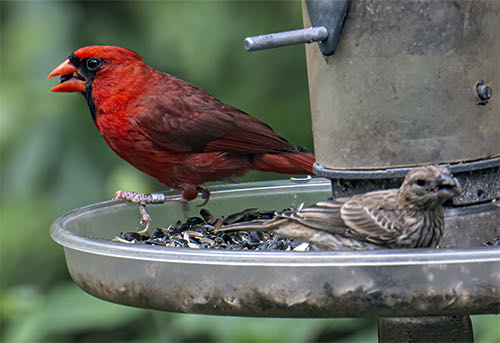
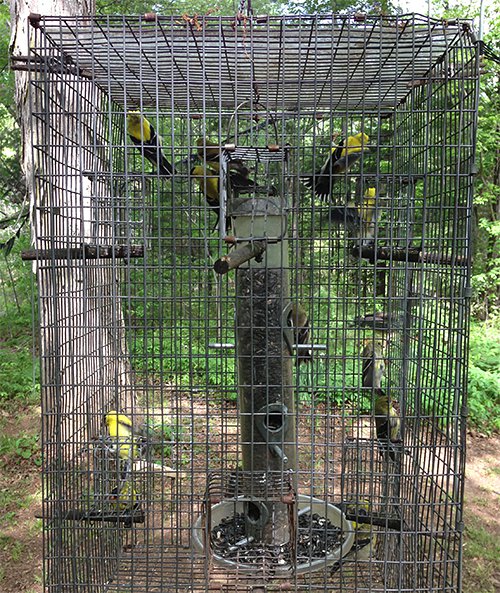
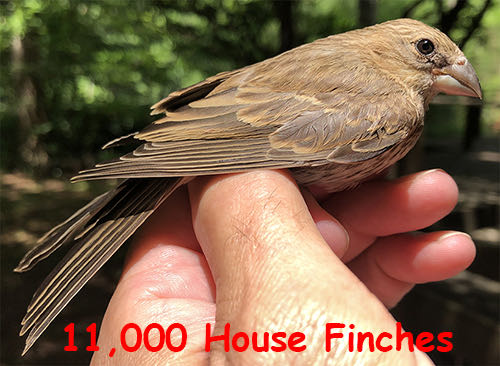
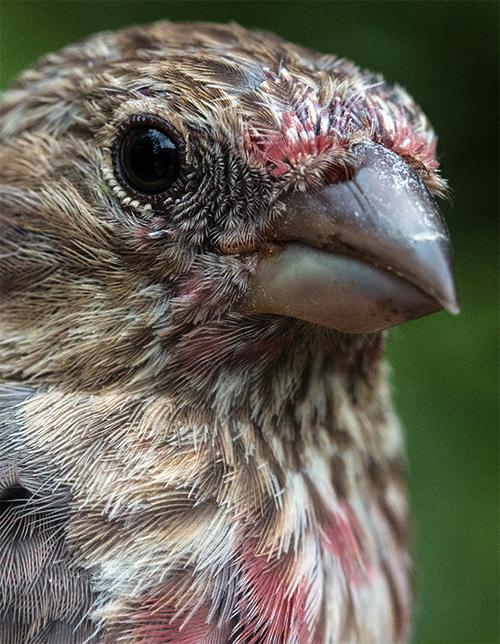


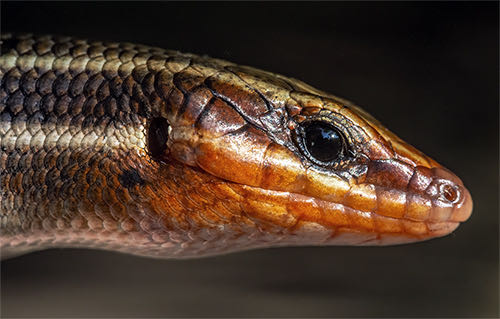
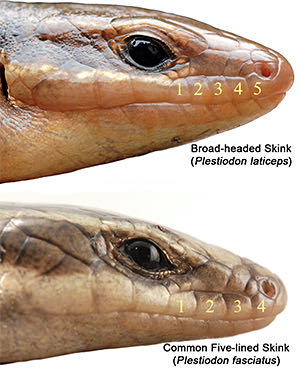 We ruled out this species and concentrated on the others, noting that one way to tell those two apart is to look at the arrangement of scales under the tail. That wasn't possible since we didn't have the lizard in-hand, but our close-up of its head held the clue.
We ruled out this species and concentrated on the others, noting that one way to tell those two apart is to look at the arrangement of scales under the tail. That wasn't possible since we didn't have the lizard in-hand, but our close-up of its head held the clue.  Those readers who THINK they could be serpentophobic might have been alarmed at first by our mug shot of the skink. For those folks, we can only suggest they be more careful observers. What clearly shows in our top photo and at right is an external ear opening at the base of the lizard's jaw--a characteristic that never occurs in serpents. Breathe easy, my friends, and please work to overcome your snake phobia!)
Those readers who THINK they could be serpentophobic might have been alarmed at first by our mug shot of the skink. For those folks, we can only suggest they be more careful observers. What clearly shows in our top photo and at right is an external ear opening at the base of the lizard's jaw--a characteristic that never occurs in serpents. Breathe easy, my friends, and please work to overcome your snake phobia!)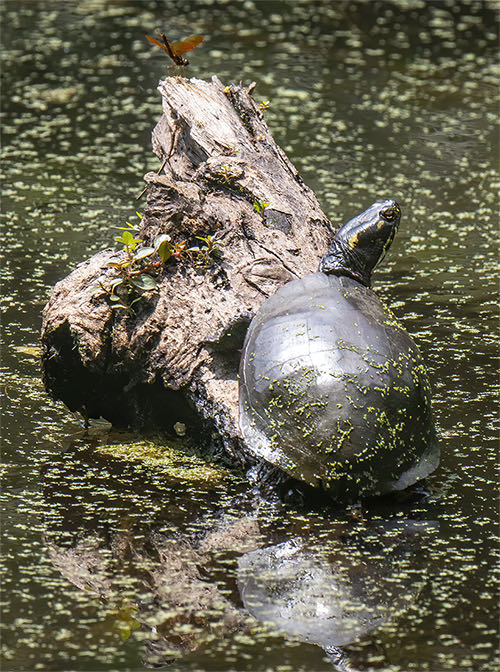
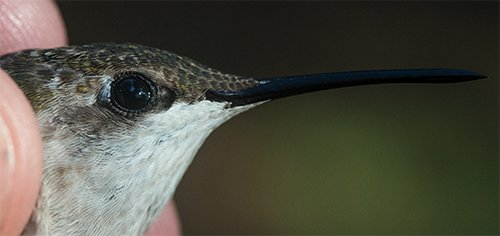
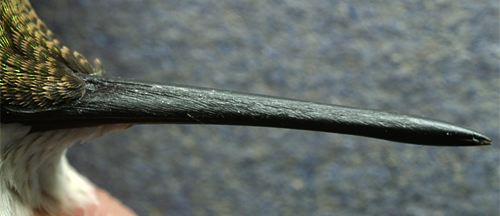
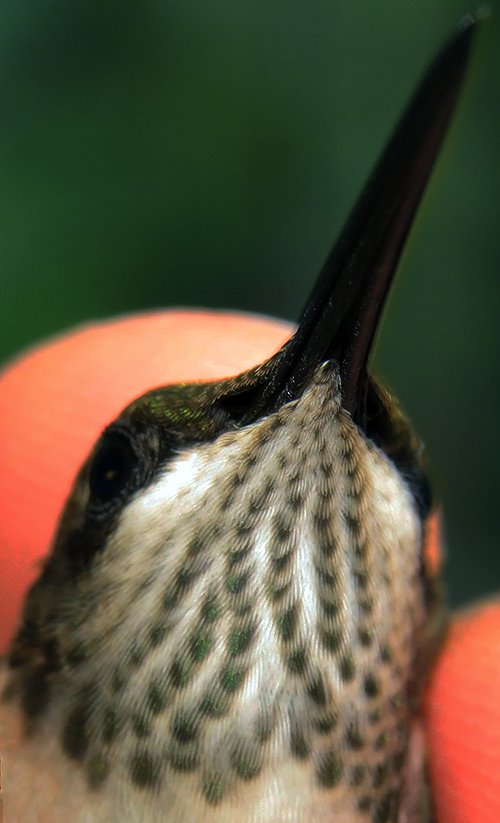

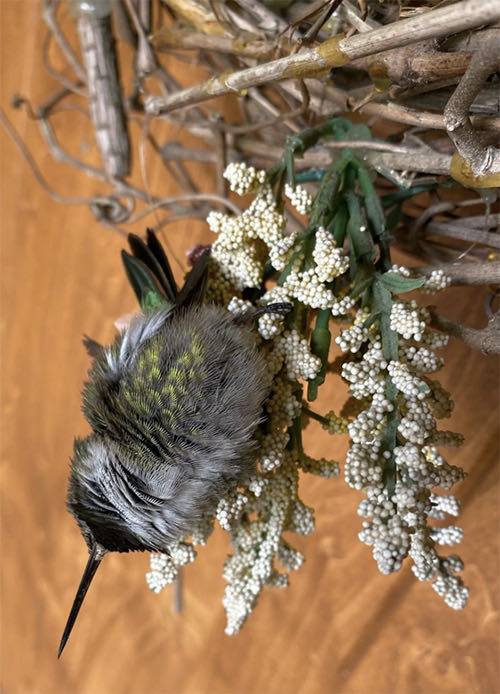
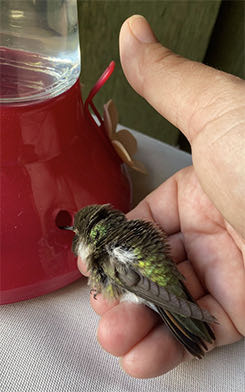 After reviewing the live video, we suggested she get small scissors and attempt to free the hummingbird from its entanglement--which Jennifer did, nervously but carefully. Once freed, however, the bird was so weak it was unable to fly, so we advised feeding it. Sadie hurried next door to borrow a sugar water feeder from a neighbor and returned post haste. As shown by the photo at right, Jennifer then popped off one of the yellow plastic flowers and gently inserted the hummingbird's bill through the feeder port. As anticipated, the undoubtedly hungry and exhausted bird began drinking.
After reviewing the live video, we suggested she get small scissors and attempt to free the hummingbird from its entanglement--which Jennifer did, nervously but carefully. Once freed, however, the bird was so weak it was unable to fly, so we advised feeding it. Sadie hurried next door to borrow a sugar water feeder from a neighbor and returned post haste. As shown by the photo at right, Jennifer then popped off one of the yellow plastic flowers and gently inserted the hummingbird's bill through the feeder port. As anticipated, the undoubtedly hungry and exhausted bird began drinking. and destruction of mist nets--PLUS damages from the follow-up mid-May windstorm--a Spring Fundraiser we started in April took on new urgency. Unfortunately, the fundraiser ended on 31 May well short of our $7,000 goal.
and destruction of mist nets--PLUS damages from the follow-up mid-May windstorm--a Spring Fundraiser we started in April took on new urgency. Unfortunately, the fundraiser ended on 31 May well short of our $7,000 goal.









 Please report your
Please report your